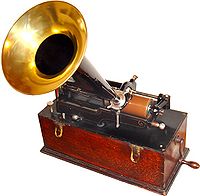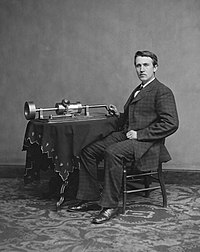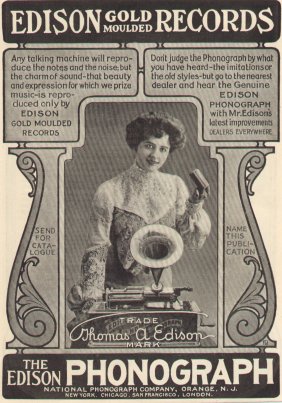今天七點到九點半參加"李志銘《單聲道:城市的聲音與記憶》新書分享會
(我兩三周前與志銘在facebook談聲音 很可以參考).....
認識了主持人胡金倫副總編輯--他私下說"下午在政大的一場編輯
另外買兩本書. 難得如此物美價廉......
我希望國內將來有聲音博物館. (正如BBC網路上有南丁格爾的幾個字的錄音.....) 更希望國史館能廣開音路.
The phonograph, record player, or gramophone (from the Greek: γράμμα, gramma, "letter" and φωνή, phōnē, "voice"), is a device introduced in 1877 for the recording and reproduction of sound recordings. The recordings played on such a device consist of waveforms that are engraved onto a rotating cylinder or disc. As the cylinder or disc rotates, a stylus or needle traces the waveforms and vibrates to reproduce the recorded sound waves.
The phonograph was invented in 1877 by Thomas Edison.[1][2][3][4] While other inventors had produced devices that could record sounds, Edison's phonograph was the first to be able to reproduce the recorded sound. His phonograph originally recorded sound onto a tinfoil sheet phonograph cylinder, and could both record and reproduce sounds. Alexander Graham Bell's Volta Laboratory made several improvements in the 1880s, including the use of wax-coated cardboard cylinders, and a cutting stylus that moved from side to side in a "zig zag" pattern across the record. At the turn of the 20th century, Emile Berliner initiated the transition from phonograph cylinders to gramophone records: flat, double-sided discs with a spiral groove running from the periphery to near the center. Other improvements were made throughout the years, including modifications to the turntable and its drive system, the needle and stylus, and the sound and equalization systems.
The gramophone record was one of the dominant audio recording formats throughout much of the 20th century. From the mid-1980s, phonograph use declined sharply because of the rise of the Compact Disc and other digital recording formats. While no longer mass market items, modest numbers of phonographs and phonograph records continue to be produced in the second decade of the 21st century.
李志銘
先生有一日本仿造的愛迪生Phonograph 不過他應該先研讀Wikipedia等對於它的說法
- phonograph
- [名]((米古風))蓄音機(((英))gramophone).phòno・gráphic[形]
phonography
- pho • nog • ra • phy
- 発音
- founɑ'grəfi | -nɔ'g-
[名][U]
1 表音式つづり方.
2 表音式速記法.
pho・nog・ra・pher
[名]留聲機(Phonograph)亦稱唱機,是一種使唱片發出聲音的機器。
其聲音儲存在以聲學方法在唱片(圓盤)平面上刻出的弧形刻槽內。
唱機旋轉部分由發條驅動,使水平圓盤和放在它上面的唱片作勻速旋轉,圓盤轉速可以由調速器控制;唱針一端有金屬膜片,膜片中心和唱針相連接;隨著唱 片轉動,唱針發生振動,由槓桿作用把振動放大,推動膜片做相應的振動,於是就可以聽到加強了的和灌片時相同的聲音;為了使唱針上的膜片的振動有效發聲,在 膜片後要接上一隻喇叭。
留聲機於1888年由美國發明家伯利那(E.Berliner,...
John Kruesi (May 15, 1843 – February 22, 1899) was a Swiss born machinist and close associate of Thomas Edison.
Career
John Kruesi had been apprenticed as a clock maker in Switzerland, and migrated to the United States where he settled in Newark, New Jersey. There, he met Thomas Edison. Edison employed him for his workshop in 1872.Kruesi became Edison's head machinist through his Newark and Menlo Park periods, responsible for translating Edison's numerous rough sketches into working devices. Since constructing and testing models was central to Edison's method of inventing, Kruesi's skill in doing this was critical to Edison's success as an inventor. Historians Robert Friedel and Paul Israel summed up Kruesi's remarkable ability of this:
:If the devices that emerged [from Kruesi's workshop] didn't work,
it was because they were bad ideas, not because they were badly made.
And when the ideas were good, as in the case of the phonograph,
the product of Kruesi's shop would prove it. (Friedel and Israel 1987, 35)Kruesi was also involved in many of Edison's key inventions. Including the quadruplex telegraph, the carbon microphone, phonograph, incandescent light bulb and system of electric lighting.
With the development of Edison's system of electric lighting, Kruesi moved to more management positions. In 1881, Edison put Kruesi in charge of the "Edison Electric Tube Company," making him responsible for the installation of underground power distribution cables from the central generating station. Kruesi was also an inventor, while at the "Electric Tube Company," he devised a two wire conduit in which two semicircular conductors were separated by an insulator and covered in insulating material. When the company merged with several others to form General Electric Company in 1892, Kruesi was promoted to General Manager, and then to Chief Mechanical Engineer at the Schenectady site in 1896.
References
- IEEE Global History Network, John Kruesi
- Hammond, John Winthrop. Men and Volts, the Story of General Electric, published 1934 by J.B.Lippincott Company. Citations: Assistant General Manager Edison Machine Works – 149; came to Schenectady – 149; Consulting engineer – 245, 276; Edison's machine-shop expert – 22; Manager Schenectady Works – 197, 242.
- Friedel, Robert, and Paul Israel. 1987. Edison's electric light: biography of an invention. New Brunswick, New Jersey: Rutgers University Press.
Kruesi, Make This!
Those three words
produced the world's
first phonograph.
Thomas Edison, America's
most famous inventor,
like to work
late at night.
He left a rough
sketch on his
assistant's desk,
with the note, " Kruesi,
make this."
When Edison got
to work about noon
the next day, Kruesi,
working from Edison's
rough sketch, had made
the world's first
phonograph.
Are you one of those
wisenheimer who
believe that to
get a job done
right,
you have to do
it yourself ?
That might be true
in eating a plate
of spaghetti;
but in little else.
In most cases
two heads
are better
than one.
Especially
if one of
them is
Edison's.
by Richard Kerr. 東京:學生社1990
wis·en·heim·er
/ˈwīzənˌhīmər/
Noun
A
person who behaves in an irritatingly smug or arrogant fashion,
typically by making clever remarks and displaying their knowledge.*****
1909年的一分55秒: http://en.wikipedia.org/wiki/Edison_Records

en.wikipedia.org
Edison Records was one of the earliest record labels which pioneered recorded so⋯⋯更多
| Edison Records | |
|---|---|
| Parent company | Thomas A. Edison, Inc. |
| Founded | June 28, 1888 Defunct October, 1929 Revived c. 1990s |
| Founder | Thomas Edison Jesse H. Lippincott |
| Status | Defunct |
| Distributor(s) | (independent, mostly through dealers, jobbers, and mail order) |
| Genre | Variety (classical, popular, etc.) |
| Country of origin | United States, some major European countries |
| Location | West Orange, New Jersey |





沒有留言:
張貼留言